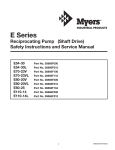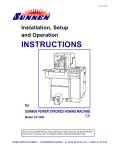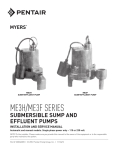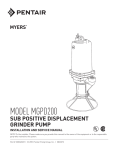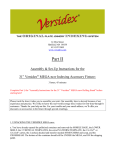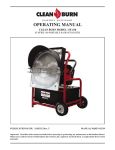Download MODEL BX - Pentair Water Literature
Transcript
MODEL BX INDUSTRIAL PUMPS INSTALLATION AND SERVICE MANUAL NOTE! To the installer: Please make sure you provide this manual to the owner of the equipment or to the responsible party who maintains the system. Part # 13800A903 | © 2012 Pentair Pump Group, Ltd. | 11/12/12 GENERAL INSTRUCTIONS E.Make sure that drive is adequate for horsepower required and that drive is properly aligned and tensioned. With belt drives, pulley on both motor and pump should be located as close as possible to bearing to reduce bearing and shaft bending loads. Reciprocating pumps of both the plunger and piston type are positive displacement in principle. Due to positive displacement characteristics, problems may arise through improper installation or application. When new or unusual installations are planned, or the material to be pumped is a liquid other than cold water, the customer should consult the “Myers Reciprocating Pump Manual” or factory for additional information. CAUTION: Be sure that pump belts and pulleys are properly protected by guards according to industrial code within state of application. F.Make sure that all bolts, nuts, set screws and keys are properly tightened. CAUTION: Positive Displacement Pumps must have a proper size and operable type of pressure regulating valve or pressure relief valve piped into the discharge line. This is mandatory to prevent damage to pump and piping or possible injury to personnel. Do not install any valves or shutoff devices in the bypass line from pressure regulator to tank or supply. G.Be sure that discharge line is properly protected by means of a pressure regulating valve and a discharge surge arrester of proper size, capacity and pressure rating. The discharge line should be of comparable size to discharge tapping in pump. Average discharge line velocity should not exceed 5 feet per second for most satisfactory operation. H.Nozzle capacity or demand should not exceed 90% of pump capacity for satisfactory regulating valve operation. Nozzling in excess of this capacity may cause unstable pressure regulator operation. It is also preferred to nozzle in excess of 50% of pump capacity to reduce rate of erosion or wear on regulating valve and seat. When lower system demands (than rated pump capacity) are required in an installation, the pump speed should be reduced by changing drive ratios. This will reflect savings in power consumption, reduced regulating valve wear and extended pump life. CAUTION: All pumps should be installed level. For mobile applications the maximum angle of intermittent operation should be no more than 5 degrees in any one direction. CALIFORNIA PROPOSITION 65 WARNING: This product and related accessories contain chemicals known to the State of California to cause cancer, birth defects or other reproductive harm. I.Where line shock or water hammer is encountered a second surge arrester should be installed in the discharge line adjacent to spray gun or nozzles. Under some conditions it may also be desirable to isolate pump from piping with a suitable high pressure hose. This will eliminate transmission of line vibration to the pump, reducing possible failure of piping, pipe threads, and/or pump casting. 1. INSTALLATION A.If possible, install suction piping one pipe size larger than suction tapping in pump. Reduce piping size at pump with a reducer coupling. A suction surge arrester will assure smoother operation. B.Keep suction piping as short and simple as possible with a minimum of lift. Avoid any high points in the suction line. Suction piping must not have any air leaks. Check suction piping assembly for leaks by using 20–80 PSI air pressure and soap bubbles or submerging assembly under water. J.Never pipe the bypass from a pressure regulating valve back into the pump suction. When the discharge line is shut off, the complete bypass is circulated back into pump suction with a resulting rapid temperature rise which will destroy the piston packing. It is permissible to pipe the bypass from an unloader into the suction because the pump pressure is unloaded when discharge is shut off. C.Use suction strainer and screen with twice the rating of the pump capacity to avoid restriction of the pump suction. Strainer mesh should be sufficiently small to prevent passage of trash which may lodge under pump valves. Keep screen clean with a regular maintenance schedule to avoid starving of pump suction. A starved suction condition is usually indicated by excessive pump shock and noise. Many pump problems and many packing or cup failures are directly traceable to a starved suction condition. 2. STARTING PUMP A.Before starting read all instructions carefully! D.When pumping liquids that are heated, reduce pump speed to avoid suction problems. Consult “Myers Reciprocating Pump Manual” or factory for temperature and speed limitations. 13800A903 11/12/12 2 1. Replace all drain plugs in pump and piping. 2. Fill pump crankcase with recommended oil to the proper level. (See Lubrication Section.) 3. Inspect tank to be sure that no foreign material is in tank or suction line. 4. Fill tank at least half full or connect suction to water supply. Open valve (if present) in suction line. If pumping from a pit, make sure that suction line is completely submerged. 5. Make sure all valves, including spray gun or nozzles, are open in discharge line. Spray gun may be anchored to discharge back into tank. 6. Completely back off pressure adjusting screw on pressure regulating valve. SAE 40 should be used. Use only good quality grade oils with SAE designation MS, SC or SD. Maintain level at mark on cover for the required RPM. Foaming or milky discoloration of oil is an indication of water. Oil should be replaced to preclude possible damage to crankcase and components. CAUTION: When pumping from a pit or under a suction lift condition, if pump does not prime in a short period, fill the discharge side of fluid end with water to seal discharge valves. If pump still does not prime remove suction hose and fill pump with water. Dry operation will cause heating and wear on cylinders and packing. Be sure that an operating pressure gauge is located on discharge line. NOTE: Drain oil from crankcase after first 30 hours of operation. It is best to always drain the oil when it is still hot. Refill the new oil as mentioned above. Run pump at full speed under no pressure for 2 or 3 minutes before returning to operation. Thereafter change oil every 300 hours or immediately if water droplets are found in crankcase. Check oil level regularly and add oil as needed. B.Starting Unit: 1. After starting, close discharge valve or gun slowly while watching pressure gauge to make sure relief valve or unloader is operating properly. 2. Adjust relief valve to desired pressure. See regulator instructions. 3. Cycle nozzles or gun on and off to be sure that pressure adjustment and regulator operation is satisfactory. RPM 800 700 600 OIL LEVEL LOCATION Add Level Mark Between Add & Full Mark Full Mark OIL CAPACITY 32 oz. 40 oz. 48 oz. Speeds of 400 to 600 RPM require 48 ounces of oil. For speeds less than 400 RPM consult factory for recommendations. Avoid Freezing by draining all water from pump and system in cold weather. This can be done by breaking suction connections and turning crankshaft over 4 or 5 times, or the fluid end can be removed to completely drain cylinders and fluid end. LUBRICATION Pump-Crankcase must be filled with 2 to 3 pints depending on RPM (See Table) of SAE 30 oil unless ambient temperature exceeds 90 degrees F when SPECIFICATIONS TYPE Rated Capacity GPM @ 800 RPM Pressure Rating: Continuous/Intermittent Required BHP @ 800 RPM and Rated Pressure Temperature Rating (Max.) Cylinder Bore Stroke Suction Size Discharge Crankshaft Diameter Keyway Cylinder Material Fluid End Material Packing Material Valve Material Seat Material Piston Material Approximate Shipping Weight Recommended Regulator Recommended Unloader Recommended Discharge Surge Suppressor TRIPLEX – SINGLE ACTING 8 GPM 1,000 PSI/1,200 PSI 6.3 140˚ F 1" 1-1/16" 1 NPT (Bottom) 3/4" NPT (Top) 1" 1/4 x 1/8 Alumina Ceramic Brass High Acrylic Nitrile Stainless Steel Stainless Steel Brass 50 lbs. 22900B000 19280C000 6CU 3 13800A903 11/12/12 SERVICE MANUAL erosion is present on valve. All valve components are interchangeable but it is recommended to put them back in the same order as taken out if not renewing the components. CAUTION: Disconnect electrical leads to motor to remove spark plug leads on engine before processing. To replace valve components, first clean bores to remove corrosion or burrs. Lubricate and replace O-ring in bottom of bore. Then the valve seat. Lubricate and replace O-ring. On the valve make sure the spring is inserted squarely inside the valve and fitted snug on the bottom of the valve seat before putting assembly into fluid end. Repeat for the discharge valve. Be extra careful not to crossthread valve cover into the fluid end. CYLINDER AND PACKING SERVICE Removal: Remove 2 cap screws holding fluid end to power end and pull straight forward using care with ceramic cylinders. Do not cock fluid end or drop cylinders. Hold onto cylinder while removing socket head cap screw through cylinder and remove cylinder with packing still inside. Remove packing with a suitable punch being careful not to scratch cylinder. Grease cylinder O.D. when replacing so that it won’t corrode in crankcase. When renewing packing, clean all piston parts, renew nylon gaskets and O-rings. Ceramic cylinders can be cleaned by soaking in muriatic acid solution to remove all buildup of packing material. CAUTION!! AVOID DIRECT CONTACT WITH MURIATIC ACID. WEAR PROTECTIVE GLOVES AND EYE PROTECTION. IF EXPOSED, FLUSH EXPOSED AREA WITH WATER. CONSULT A PHYSICIAN FOR TREATMENT OF MURIATIC ACID BURNS. Clean bores in fluid end and power end. Be sure to replace nylon gasket in crankcase before replacing cylinder. Insert cap screw with lock washer through cup, replace piston, renew gasket and lubricate cup. With the lips of the cup away from the cylinder, insert assembly through the cylinder in the end that has a chamfer on the O.D. Make sure the gasket is on the cap screw and insert assembly into crankcase. Care should be used to assure proper seating of cylinder into the machined opening at the rear of the bore. With the cylinder seated properly, the piston assembly adjusted and locked in place to 5–6 ft./lbs., and the O-ring lubricated and in the fluid end, the fluid end can be replaced. Insert cap screws and pull down finger tight. Do not cock fluid end while tightening. Pull evenly by alternately tightening to a final torque of 90–100 ft./lbs. SERVICING CRANKCASE PARTS To remove crankshaft, the plungers and cylinders must first be removed, as explained earlier. Drain oil from crankcase and remove rear cover. Remove retainer ring from bearing bore. The connecting link caps should be taken off and the free links pushed toward the water end as far as possible. BEFORE REMOVAL, BE SURE TO NOTE THE MARKINGS ON THE CONNECTING LINKS AND CAPS. THESE PARTS ARE NOT INTERCHANGEABLE AND MUST BE REASSEMBLED IN THEIR ORIGINAL POSITIONS. The crankshaft bearings and bearing cap can now be removed by tapping with a hammer against a block of wood on one end of the crankshaft. The crankshaft should be supported so that as the bearings leave the bores the crank does not drop and damage a crank pin. Do not remove bearing from crankshaft unless replacement is necessary. After removing crankshaft, the links and crosshead can be pulled of out the crankcase opening. NOTE: Replaced with packing kit 23716A010K. VALVE SERVICE When servicing valves always renew O-rings. Remove valve covers on top of fluid end for access to valve components. Suction and discharge valves will show a wear pattern on seating surface but need not be replaced unless extreme wear, cracks, or 13800A903 11/12/12 4 SERVICING CONNECTING LINK REPLACING CROSSHEAD SEALS The connecting links should be checked for bearing wear only if the pump shows signs which might be due to a failing link or during a general overhaul. The link is made of material that has bearing qualities. It does not require a crankshaft bearing and should last many hours if properly cared for. With the crankshaft and crossheads removed, the worn seals can be pried out. When installing new seals be sure to place them with the lip facing the power end and the metal face toward the water end. After cleaning the cavity and wiping with oil, the seal can be pressed into place with an arbor press or by tapping lightly with a hammer against a block of wood. The seals should be pressed in as shown in cutaway pump view. When returning crossheads through new seals care should be taken not to turn back or damage the lip of the seal. An assembly thimble can be very helpful in this operation. Fig. 4 shows a recommended thimble for installation of oil seals. The wrist pin will slide out as it has a slide fit on both the crosshead and link. When replacing the pin be sure the link operates freely on the crosshead. Torque for the link bolts is not to exceed 144 in./lbs. or 12 ft./lbs. The following should be done by a qualified machine shop. If the wrist pin hole of the link has a clearance of .004 or more it can be salvaged by drilling and reaming to the dimension in Fig. 3 to accommodate 05806A030 bronze bushing. When drilling and reaming make sure it is parallel to the large diameter of the link. It may be necessary to ream the bushing I.D. to the dimension in Fig. 3 after bushing is installed. It is required to renew the whole link if the clearance between the link and crank becomes greater than .005 or it may be salvaged by machining equal amounts of material where the link and link cap meet but not to exceed .015 each end. Then rebore and rehone to a fine finish to the dimension in Fig. 3. Also a radius should be machined to the sides to match the crank. The diameters will have to be perpendicular to the machined sides of the link. After replacing the crossheads and links, they should be pushed all the way forward; then the crankshaft can be replaced just as it was removed. All link caps should be tightened in place and free operation of the crank assured before replacing bearing cap and retainer ring. When replacing bearing cap, place a strip of electrical tape over the crankshaft keyway to reduce possibility of seal lip damage. Clean and lubricate all seals and O-rings before replacing. CAUTION: Overtightening of rear cover screws could result in fracturing cover. Do not clean rear cover with solvents or harsh chemicals. RECONDITIONING CRANKSHAFTS When only a very small amount of damage has occurred on the crank pins, such as small surface grooves cut partway round the bearing surface, the crank pins can sometimes be reconditioned for further use. This can be done with emery cloth and polishing until all ridges are completely removed. The final polishing operation should be performed by using a very fine emery cloth. The procedure can be followed only where the amount of sanding does not reduce the normal diameter of the crank pin. If the crankshaft cannot be refinished by hand in this manner, it will be necessary to build up the journals, then regrind and polish to the original diameter of 1.37275 to 1.37225 in. with a 12 micro finish. 5 13800A903 11/12/12 BX6-12 INDUSTRIAL PUMP PARTS LIST 13800A903 11/12/12 6 BX8-15 INDUSTRIAL PUMP PARTS LIST 7 13800A903 11/12/12 STANDARD LIMITED WARRANTY CENTRIFUGAL & RECIPROCATING PUMPS Pentair Myers® warrants its products against defects in material and workmanship for a period of 12 months from the date of shipment from Pentair Myers or 18 months from the manufacturing date, whichever occurs first – provided that such products are used in compliance with the requirements of the Pentair Myers catalog and technical manuals. During the warranty period and subject to the conditions set forth, Pentair Myers, at its discretion, will repair or replace to the original user, the parts that prove defective in materials and workmanship. Pentair Myers reserves the right to change or improve its products or any portions thereof without being obligated to provide such a change or improvement for prior sold and/or shipped units. Seals, piston cups, packing, plungers, liners and valves used for handling clear, fresh, nonaerated water at a temperature not exceeding 120ºF are warranted for ninety days from date of shipment. All other applications are subject to a thirty day warranty. Accessories such as motors, engines and auxiliary equipment are warranted by the respective manufacturer and are excluded in this standard warranty. Under no circumstance will Pentair Myers be responsible for the cost of field labor, travel expenses, rented equipment, removal/reinstallation costs or freight expenses to and from the factory or an authorized Pentair Myers service facility. This limited warranty will not apply: (a) to defects or malfunctions resulting from failure to properly install, operate or maintain the unit in accordance with the printed instructions provided; (b) to failures resulting from abuse, accident or negligence; (c) to normal maintenance services and parts used in connection with such service; (d) to units that are not installed in accordance with applicable local codes, ordinances and good trade practices; (e) if the unit is moved from its original installation location; (f) if unit is used for purposes other than for what it is designed and manufactured; (g) to any unit that has been repaired or altered by anyone other than Pentair Myers or an authorized Pentair Myers service provider; (h) to any unit that has been repaired using non factory specified/OEM parts. Warranty Exclusions: Pentair Myers MAKES NO EXPRESS OR IMPLIED WARRANTIES THAT EXTEND BEYOND THE DESCRIPTION ON THE FACE HEREOF. Pentair Myers SPECIFICALLY DISCLAIMS THE IMPLIED WARRANTIES OF MERCHANTABILITY AND FITNESS FOR ANY PARTICULAR PURPOSE. Liability Limitation: IN NO EVENT SHALL Pentair Myers BE LIABLE OR RESPONSIBLE FOR CONSEQUENTIAL, INCIDENTAL OR SPECIAL DAMAGES RESULTING FROM OR RELATED IN ANY MANNER TO ANY Pentair Myers PRODUCT OR PARTS THEREOF. PERSONAL INJURY AND/OR PROPERTY DAMAGE MAY RESULT FROM IMPROPER INSTALLATION. Pentair Myers DISCLAIMS ALL LIABILITY, INCLUDING LIABILITY UNDER THIS WARRANTY, FOR IMPROPER INSTALLATION. Pentair Myers RECOMMENDS INSTALLATION BY PROFESSIONALS. Some states do not permit some or all of the above warranty limitations or the exclusion or limitation of incidental or consequential damages and therefore such limitations may not apply to you. No warranties or representations at any time made by any representatives of Pentair Myers shall vary or expand the provision hereof. 1101 MYERS PARKWAY ASHLAND, OHIO, USA 44805 419-289-1144 WWW.FEMYERS.COM Warranty Rev. 12/13











